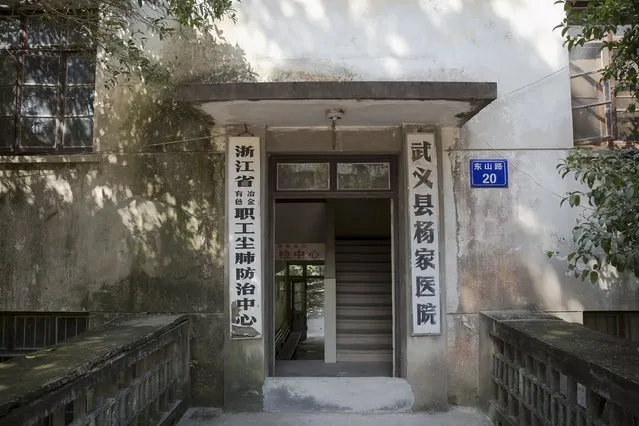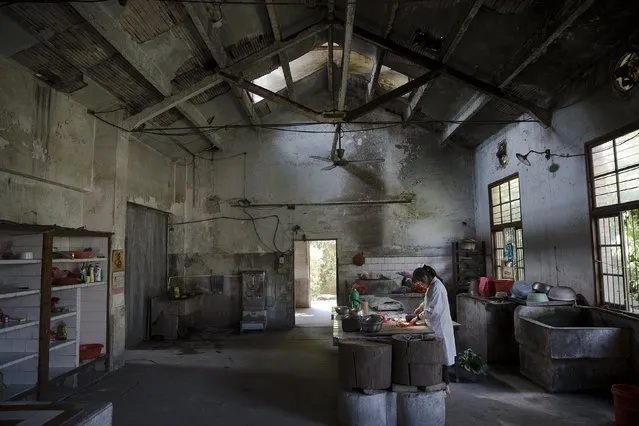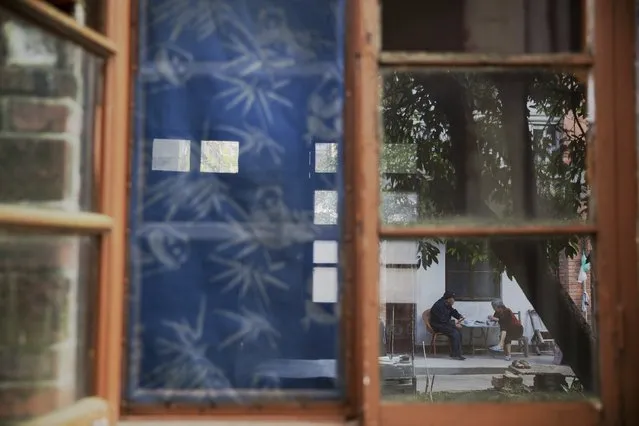
The entrance to Yangjia Hospital is seen in Wuyi County, Zhejiang Province, China October 19, 2015. At Yangjia Hospital in a remote corner of China's eastern Zhejiang province, sufferers of dust lung spend much of their time hooked up to oxygen to treat lungs ravaged by work in a local mine, since shut down. Once equipped with high-tech machinery and 150 staff, the hospital has suffered from falling numbers and a lack of funding. With some of its windows broken and certain rooms abandoned, the hospital now treats just 30 patients. It's a close-knit community including family members, who prepare meals in makeshift kitchens, grow vegetables in the grounds and play cards to kill time. Dust lung, also known as pneumoconiosis, affects an estimated 6 million workers in China. (Photo by Damir Sagolj/Reuters)

Fu Jianghua (R), head of Yangjia Hospital, and a member of his staff talk to patients, who are wearing nasal cannulas for oxygen supply, in their room at the hospital in Wuyi County, Zhejiang Province, China October 19, 2015. Fu Jianghua has worked at Yangjia Hospital since 1983, when it was operated by a local mine, and he is now the hospital's head. (Photo by Damir Sagolj/Reuters)

Wang Tianfang, a 87 year old pneumoconiosis patient smokes next to an oxygen supply, which he needs several hours per-day, in his room at Yangjia Hospital in Wuyi County, Zhejiang Province, China October 19, 2015. Tianfang, a former miner, was diagnosed with dust lung in 1973 and has lived at Yangjia Hospital for two years. (Photo by Damir Sagolj/Reuters)

A pneumoconiosis patient rests between floors at Yangjia Hospital in Wuyi County, Zhejiang Province, China October 19, 2015. (Photo by Damir Sagolj/Reuters)

Used medicine bottles and other waste items are left on the stairs of Yangjia Hospital in Wuyi County, Zhejiang Province, China October 19, 2015. (Photo by Damir Sagolj/Reuters)

Fu Jianghua (L), the head of Yangjia Hospital, checks a patient in the hospital in Wuyi County, Zhejiang Province, China October 19, 2015. Fu Jianghua has worked at Yangjia Hospital since 1983, when it was operated by a local mine, he is now the hospital's head. (Photo by Damir Sagolj/Reuters)

Hu Hushen, a 78 year old former miner, breathes using a nasal cannula for oxygen supply outside his room at Yangjia Hospital in Wuyi County, Zhejiang Province, China October 19, 2015. Hu was diagnosed with pneumoconiosis, a disease caused by the inhalation of dust, in 1976 and stopped working the same year. The former miner decided to move to Yangjia Hospital nine years ago because it's cheap - the oxygen is free and almost everything else is covered by his insurance. Hu has needed a constant oxygen supply for past five years. (Photo by Damir Sagolj/Reuters)

A member of staff prepares lunch for her colleagues in a dilapidated service building at Yangjia Hospital in Wuyi County, Zhejiang Province, China October 19, 2015. (Photo by Damir Sagolj/Reuters)

A rooster and chicken walk about an empty room in an abandoned building at Yangjia Hospital in Wuyi County, Zhejiang Province, China October 19, 2015. (Photo by Damir Sagolj/Reuters)

A book with comments and suggestions by patients and their relatives hangs of the wall at Yangjia Hospital in Wuyi County, Zhejiang Province, China October 19, 2015. (Photo by Damir Sagolj/Reuters)

Pneumoconiosis patients and their relatives eat lunch and socialise at Yangjia Hospital in Wuyi County, Zhejiang Province, China October 19, 2015. (Photo by Damir Sagolj/Reuters)

Wang Ninde, whose husband is a former miner suffering from pneumoconiosis, prepares lunch at a makeshift kitchen in Yangjia Hospital in Wuyi County, Zhejiang Province, China October 19, 2015. (Photo by Damir Sagolj/Reuters)

Liu Zhonggen, a 68-year-old former miner, rests in his room at Yangjia Hospital in Wuyi County, Zhejiang Province, China October 19, 2015. According to his wife, who also lives at the hospital, Liu Zhonggen came to the hospital last year after he had stroke. The family decided to move to Yangjia Hospital because it's cheap, the insurance pays for Liu expenses and his wife pays 6 RMB per-day to stay with him. (Photo by Damir Sagolj/Reuters)

A rice cooker and other possessions belonging to Wang Xinglong are seen in his room at Yangjia Hospital in Wuyi County, Zhejiang Province, China October 19, 2015. Wang, who was diagnosed with pneumoconiosis as a young man, spends ten days every year at the hospital having health checks. (Photo by Damir Sagolj/Reuters)

Patients and their relatives play cards in a dilapidated service building at Yangjia Hospital in Wuyi County, Zhejiang Province, China October 19, 2015. (Photo by Damir Sagolj/Reuters)

Fu Jianghua, the head of Yangjia Hospital, shows an x-ray image of what he describes as a typical case of pneumoconiosis, a disease caused by the inhalation of dust, at Wuyi County, Zhejiang Province, China October 19, 2015. Fu has worked at Yangjia Hospital since 1983, when it was operated by a local mine, and is now the hospital's head. (Photo by Damir Sagolj/Reuters)

Pneumoconiosis patients and their relatives pass the time after lunch at Yangjia Hospital in Wuyi County, Zhejiang Province, China October 19, 2015. (Photo by Damir Sagolj/Reuters)

Yang Yang, an x-ray technician, poses for a photograph under the red light in his lab in the radiology department of Yangjia Hospital in Wuyi County, Zhejiang Province, China October 19, 2015. Behind the vine-covered walls and broken windows of the radiology department, a single staff member and a single X-ray machine serve the few remaining pneumoconiosis patients at Yangjia Hospital. (Photo by Damir Sagolj/Reuters)

A pneumoconiosis patient and his wife are reflected in a window as they eat lunch at Yangjia Hospital in Wuyi County, Zhejiang Province, China October 19, 2015. (Photo by Damir Sagolj/Reuters)

Medical and X-ray files are stored in the radiology department of Yangjia Hospital in Wuyi County, Zhejiang Province, China October 19, 2015. (Photo by Damir Sagolj/Reuters)

Pneumoconiosis patients and their relatives prepare wood for cooking at Yangjia Hospital in Wuyi County, Zhejiang Province, China October 19, 2015. (Photo by Damir Sagolj/Reuters)

A pneumoconiosis patient and a friend pass the time near Yangjia Hospital in Wuyi County, Zhejiang Province, China October 19, 2015. (Photo by Damir Sagolj/Reuters)

Wang Zhengqing, a 74 year old pneumoconiosis patient, smokes his pipe at Yangjia Hospital in Wuyi County, Zhejiang Province, China October 19, 2015. Former miner Wang was diagnosed with the disease, which is caused by dust inhalation, when he was 24 and has lived at Yangjia Hospital for ten years. (Photo by Damir Sagolj/Reuters)

Fu Jianghua (R), head of Yangjia Hospital, and a member of his staff talk to patients in a room at Yangjia Hospital in Wuyi County, Zhejiang Province, China October 19, 2015. Fu Jianghua has worked at Yangjia Hospital since 1983, when it was operated by a local mine, he is now the hospital's head. (Photo by Damir Sagolj/Reuters)

Two pairs of shoes are left on the windowsill of a building used by patients and their relatives at Yangjia Hospital in Wuyi County, Zhejiang Province, China October 19, 2015. (Photo by Damir Sagolj/Reuters)

Numbers used on X-ray images are placed at a desk in the radiology department of Yangjia Hospital in Wuyi County, Zhejiang Province, China October 19, 2015. Behind the vine-covered walls and broken windows of the radiology department, a single staff member and a single X-ray machine serve the few remaining pneumoconiosis patients at Yangjia Hospital. (Photo by Damir Sagolj/Reuters)
31 Oct 2015 08:00:00,
post received
0 comments
